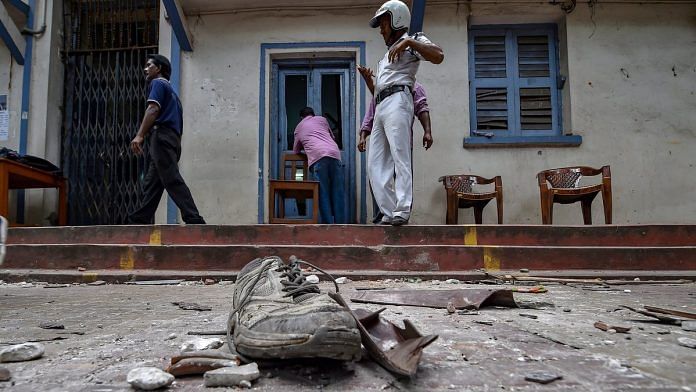New Delhi: Kolkata witnessed unprecedented violence Tuesday during BJP president Amit Shah’s rally when party workers clashed with Trinamool Congress supporters outside College Street. Suspected BJP workers also vandalised polymath Ishwar Chandra Vidyasagar’s statue.
In Bengal, political violence has been the recurrent theme this election, with three deaths reported over six phases of polling. Many more have been injured.
But the state is no stranger to political violence. According to Election Commission figures, the 2014 parliamentary elections saw seven people getting killed and another 740 injured in the state. In the 2009 Lok Sabha elections, there were three deaths in poll-related violence in Asansol and Murshidabad. The 2015 civic elections in Bengal saw four deaths and 462 incidents of poll-related violence. The panchayat elections last year saw at least 13 poll-related deaths.
This is not to say that other states have not experienced political violence, but unlike states such as Kerala, in Bengal, the trend dates back to the early 1900s.
A radical streak & Naxalbari
According to professor Samantak Das of Jadavpur University, political violence in Bengal dates back to 1905, when British Viceroy Lord Curzon announced the decision to partition Bengal. Right up until Independence, incidents of violent clashes continued to take place in Bengal.
“There is a certain kind of radical politics linked to Bengal; violence has been part of the political psyche of the state. Khudiram Bose, Netaji Bose… the Independence movement has examples galore,” said Das.
After Independence, Bengal’s politics took a violent turn in the 1960s with the Naxalbari movement.
“Naxalites took to violence because they did not believe in elections and democracy. The Congress, which ruled the state at that time, further perpetuated the violence mostly in urban areas. The Left was at the receiving end,” Das said.
The cycle continued after the Congress finally lost its hegemony in 1977, and the Left Front came to power. The initial period of Left rule was relatively peaceful with sporadic incidents of state-sponsored violence.
“In the initial years, the Left was busy implementing land reforms and developing rural areas. Its energy was focused on more constructive work,” said a political expert who did not want to be named.
The Left, the expert said, started unravelling after the Indian economy was liberalised in the 1990s. It put the Left in a spot because of its anti-liberalisation stand — its policies resulted in an acute jobs crisis, especially in rural areas. People did not have anything to do. It was also the time that old-timers got sidelined and the Left ranks were filled with hooligans and strongmen. Violence, especially in rural Bengal, became the order of the day.
Also read: EC issues unprecedented order, ends Bengal campaign a day early
Trinamool a match for the Left
By this time, Mamata Banerjee had left the Congress and formed the Trinamool Congress.
“Trinamool realised that you can’t take on the might of the ruling party if you are not violent. The period between 2007-2011 was one of the most violent phases in recent times,” said Amal Kumar Mukhopadhyaya, political scientist and former principal of Presidency College.
Das added that the Trinamool rode to power on violent farmers’ agitations in Nandigram and Singur.
Once in power, the Trinamool kept up the pace. “It’s a party without any vision, and is run by a motley group of anti-socials. They resorted to violence to terrorise the people, took refuge in caste and identity politics to remain in power,” said the expert quoted above who didn’t want to be named.
The 2018 panchayat elections were a glaring example of how the Trinamool used violence to swing the election in its favour. These Lok Sabha elections, experts say, are do-or-die for the party, since it knows that the only way it can remain relevant is by being in power.
BJP adding a new dimension
The BJP, which is trying to make inroads into Bengal, has now added its own brand of violence with a communal touch. Using the Hindutva plank, it is trying hard to polarise voters. In the last three or four years, West Bengal has witnessed many small-scale communal flare-ups, including the violence during Ram Navami festivities in Asansol in 2017.
But, political pundits are still divided on who will benefit from the latest round of violence in Bengal. Banerjee is already talking of how Bengal’s pride has been hurt after BJP supporters vandalised Vidyasagar’s statue, while the BJP is playing the victim card.
Also read: Vidyasagar statue vandalism in Bengal isn’t just about ideology. It’s a TMC-BJP power war




AN ESSAYTHAT PORTRAYS INDIAN POLITICS. WHATVER THE PARTY UNLESS THEY ADOPT VIOLENCE THEY CAN NOTWIN ELCTIONS